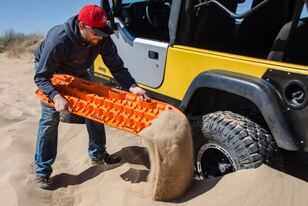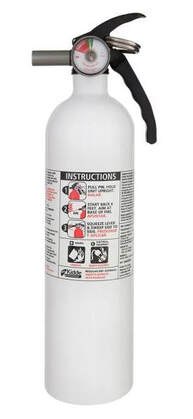Basic Recovery Gear
|
If you have a frame mounted trailer hitch it can be used as a recovery point. Ideally a receiver with a clevis would be used as both items are secured with no chance of the strap slipping off. A variation of this would be a receiver with a hook which is not as desirable. Under no circumstances should a trailer ball be used for a recovery point. The clevis must have a screw in pin otherwise it may elongate during a difficult recovery. You can also paint your clevis and reciter to easily identify it as yours. Costs range from $40-$60
|
|
If you have a D-ring or shackle bracket on your bumper a Clevis or D-Ring is a very secure attachment point. The clevis/D-ring must be the screw type (no pins) as this provides additional rigidity to the recovery point. Under no circumstances is is acceptable to join two two straps together with a clevis/D-Ring. The D-ring/clevis must be secured direct to a vehicle or other fixed item such as a snatch block. Feel free to paint it to match your vehicle or a color other than silver or black to easily identify yours! They also make a rubber insulator to keep them from rattling. They should be rated at least 3X or 4X your vehicles weight and make sure the screw size works with your attachment point as they come in 1/2 and 3/4-inch sizes. Cost ranges from $15-$30
|
|
Hi-lift or bar jacks are not suggested for basic recovery options. The best advice is if you have never operated one don't buy one. They can be dangerous if not used properly. They are many creative uses for a hi-lift jack. They also have many accessories such as bases and hooks to aid in lifting or recovery. Costs range from $50=$100
|
|
Traction boards are becoming more popular and ideal for sand and snow situations. Care should be taken when placing and using any traction aiding device such as these. If not used properly they may become a lethal projectile so proper distancing is required. Traction boards may also be used as a shovel as shown in this photo. Be sure to secure all trail gear securely inside the vehicle at all times.
|
Associated Recovery Items For Use With Winches
|
A tree saver is just that a means to protect the tree from damage of a winch cable. Do not wrap a winch cable around the true as it can damage the tree and even kill it. The tree saver is about 4-inches wide and about 6-foot in length. The ends may be either attached directly to a winch cable hook or joined together with a clevis/D-ring. Costs range from $20-$60
|
|
Consider a pair pf good quality leather gloves for handling wire rope style winch cables. Gloves should be snug and not too loose to get caught in cables and winches. Mechanic style gloves are good for other applications such as changing tires. Safety glasses are also highly recommended when working on a vehicle or performing a recovery.
|
Communication Equipment
Generally the club uses a 40-channel CB (Citizens Band) radio which does NOT require a FCC license. Radios come in various sizes and features but they all basically do the same thing. They are limited to 4-watt output so it should transmit a couple of miles depending on the terrain. More critical than the radio itself is the antenna, The antenna may be a magnetic mount or attached more permanently to the vehicle. Basic CB radios start about $50 and a decent antenna starts at $40 and can go to more than $100!!! The radio can be hard wired directly to a 12-volt source or use a lighter plug which are generally under $10.
Some of the club members are also licensed amateur (ham) radio operators which requires a special radio. For mobile use the club utilizes the 2-meter band which offers FM transmission. Think of CB like a AM radio which can have static and ham radio which is FM or virtually static free. Ham radios are also permitted to have higher outputs resulting in longer distance transmissions. They may also use repeaters to extend their reach even further. Please contact one of our licensed ham radio club members to learn more. You will need to pass the ham radio test which is a multiple choice and you can review all the questions on line with answers. Morse code is NO longer a requirement. Hand held radios start under $50 and a mobile unit with an antenna would start at about $200
Safety
|
There are too many first aid kits available to even narrow it down a bit. A word of caution is most commercial kits are designed based a certain number of people. For the most part your first aid kit should consist of sufficient supplies for all of your passengers and with the items you are comfortable in using. There is no sense in carrying a tracheotomy kit if you do not have the training to use it correctly. Be prepared for the unexpected and ensure your supplies are within current dates. You can start with a commercial kit then add/subtract items to your liking. If you or a passenger has an allergy then a epipen may be required, The other option is to start with an empty bag or ammo style can and create your own special kit. Don't forget the basic H2O bottle of water for washing out cuts and for your own hydration. The choices are endless but this is a must have.
|
|
A flashlight is another great safety item. It can not only help you see things when it's dark but it can also make you seen as well. Choose one that fits in the space you have and make sure it is secured and accessible. LED bulbs provide lots of light with very little battery draw. Check you flashlight on a regular basis as having dead batteries makes this item useless.
|
|
While we hope that it will never be used carrying and knowing how to use a fire extinguisher is always encouraged.
Class A Fires Fueled by organic, combustible materials such as wood, cloth, paper, rubber, and many plastics. Class B Fires Fueled by flammable liquids, combustible liquids, petroleum greases, tars, oil-based paints, solvents, lacquers, alcohol, and flammable gases. Class C Fires Electrical fires involving energized electrical equipment, such as short-circuiting machinery and overloaded electrical cables. Look for at least a class B/C if not an ABC rated fire extinguisher. Just like the smoke detectors in your house they should be checked annually and replaced if needed or once they are used. |
It is sometimes the little things like tie-wraps or duct tape that can save the day as well. Start putting together an extra bag/box of simple tools and parts for a trail fix. Then plan on never using it for personal reasons!
Be prepared for the elements! Think about where you are going and picture the trip now taking twice or 4 times as long. What would make it more comfortable? A blanket can have many uses besides keeping a person warm, Rain coats or a tarp can help keep you warm and dry. Hats and sunglasses can really make a difference in your comfort level. Don't forget the bug spray or sunscreen either! Be prepared as you may need a cooling towel during the day and a pair of chemical hand warmers at night.
Don't forget to pack your lunch and favorite non-alcoholic drink as well. Include a couple of bottles of water not only for drinking but also for washing out cuts and abrasions. Pre-packaged crackers, peanuts and trail mix has a good shelf life and can come in handy for those unexpected times when a quick snack is required. Hard candy can also be a quick sugary picker upper as well. Trail cuisine is up to you but it should be simple and not require a camp stove to prepare it. The cooler you already own is probably just fine but make sure it can be secured to your vehicle. We also suggest you have trash bags as generally we end up picking trash left behind by others. Pack out what you brought in!
Be prepared for the elements! Think about where you are going and picture the trip now taking twice or 4 times as long. What would make it more comfortable? A blanket can have many uses besides keeping a person warm, Rain coats or a tarp can help keep you warm and dry. Hats and sunglasses can really make a difference in your comfort level. Don't forget the bug spray or sunscreen either! Be prepared as you may need a cooling towel during the day and a pair of chemical hand warmers at night.
Don't forget to pack your lunch and favorite non-alcoholic drink as well. Include a couple of bottles of water not only for drinking but also for washing out cuts and abrasions. Pre-packaged crackers, peanuts and trail mix has a good shelf life and can come in handy for those unexpected times when a quick snack is required. Hard candy can also be a quick sugary picker upper as well. Trail cuisine is up to you but it should be simple and not require a camp stove to prepare it. The cooler you already own is probably just fine but make sure it can be secured to your vehicle. We also suggest you have trash bags as generally we end up picking trash left behind by others. Pack out what you brought in!














